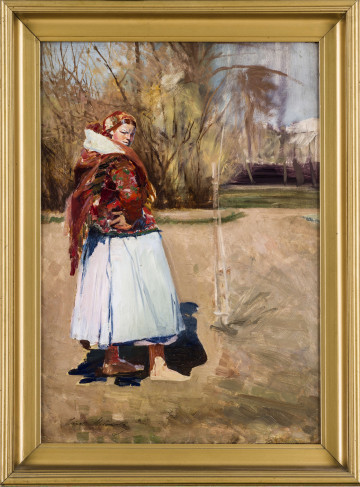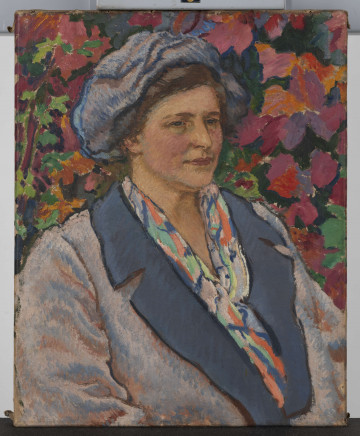
Study of a countrywoman
1900 — 1910
National Museum in Lublin
Part of the collection: Portrait
In the work of Piotr Stachiewicz there is a fascination with folklore, which for many Young Poland painters, who perpetuated the customs, rituals and colourfulness of peasant clothing on canvas, was an expression of patriotic attitudes combined with a belief that Polish art can be revived thanks to the people and nature. Between 1877 and 1883, Piotr Stachiewicz studied at the Krakow School of Fine Arts under Matejko, F. Cynk and W. Łuszczkiewicz, and then at the Academy of Fine Arts in Munich under O. Seitz. The artist was the author of historical and religious scenes, the most famous of which is the cycle “The Legend of Virgin Mary”. He created series of paintings based on novels of H. Sienkiewicz and the poetry of A. Mickiewicz as well as book illustrations to Sienkiewicz's Quo vadis?, Bajki [Tales] by J. I. Kraszewski and poems by M. Konopnicka. He was famous for his subtle depictions of women, often using the motif of a milkmaid who was painted in the traditional Krakow costume, a colourful kerchief on her head, with milk cans carried on her back in a shawl. In the version of the painting owned by the National Museum in Lublin, Stachiewicz combined the lyrical sensitivity of a winter landscape with his typical tendency to idealize the title character and the decorative values of folk costumes. The artist's favourite model - Zofia Frontczakówna, who had been portrayed by him many times - posed for Mleczarka [The Milkmaid]. Coming from a peasant family living in Dubnia near Krakow, the girl was famous for her extraordinary beauty, and for this reason she was called beautiful Zośka. Thanks to her mother's efforts, she quickly gained popularity among Krakow's artists. She was painted by, among others: W. Kossak and W. Wodzinowski. Not only Frontczakówna's exceptional beauty, which made her popular, but also her tragic life went down in history. A turbulent marriage with a shoemaker, Maciej Paluch, full of conflicts caused by aggression and jealousy, led to Zofia's death. In 1927 she was murdered by her husband.
Anna Hałata
Author / creator
Dimensions
cały obiekt: height: 58 cm, width: 45 cm
Object type
drawing
Technique
pastel
Material
paper
Creation time / dating
Creation / finding place
Owner
The National Museum in Lublin
Identification number
Location / status

1900 — 1910
National Museum in Lublin

National Museum in Lublin

National Museum in Lublin
DISCOVER this TOPIC
Museum of King Jan III's Palace at Wilanów
DISCOVER this PATH
Educational path